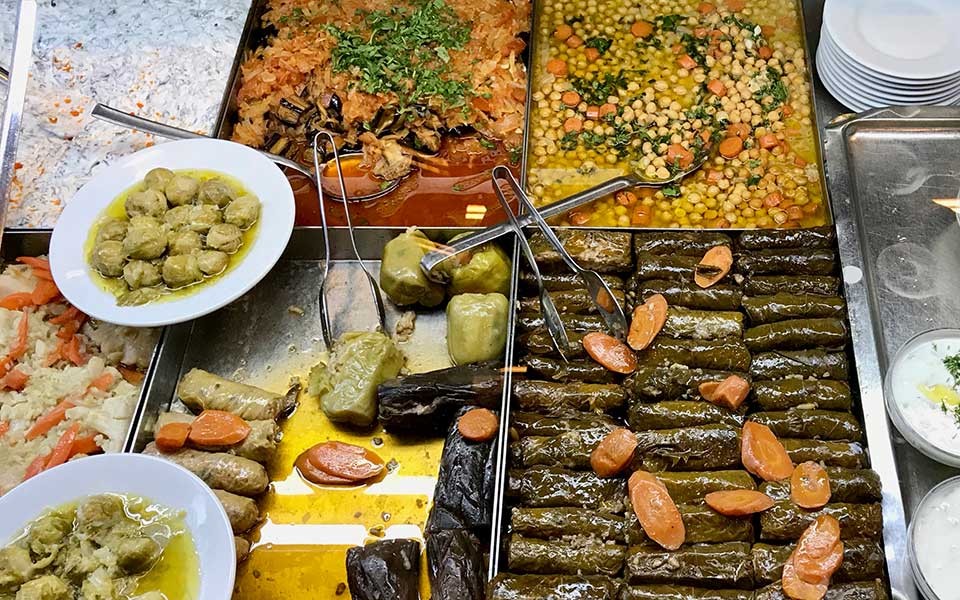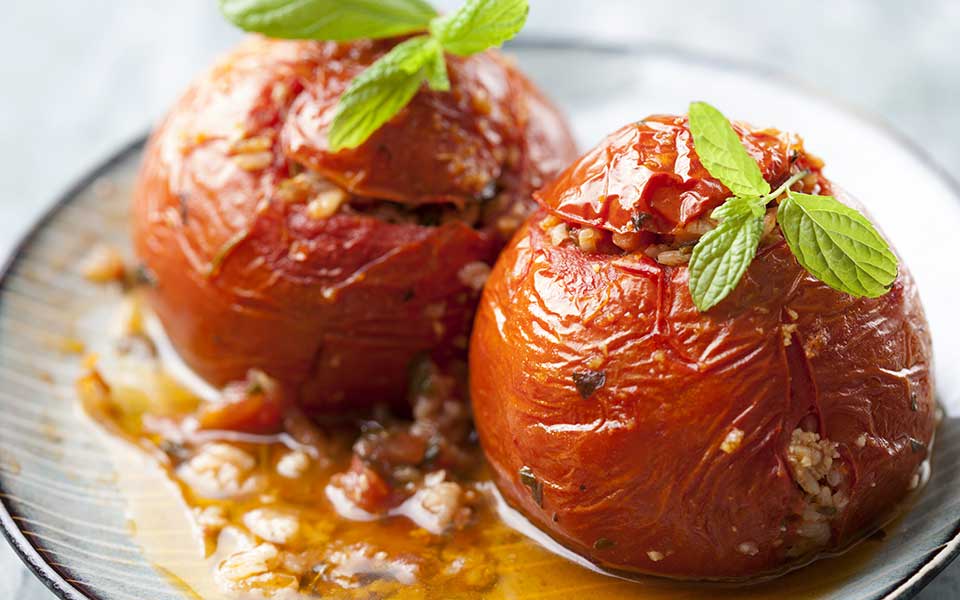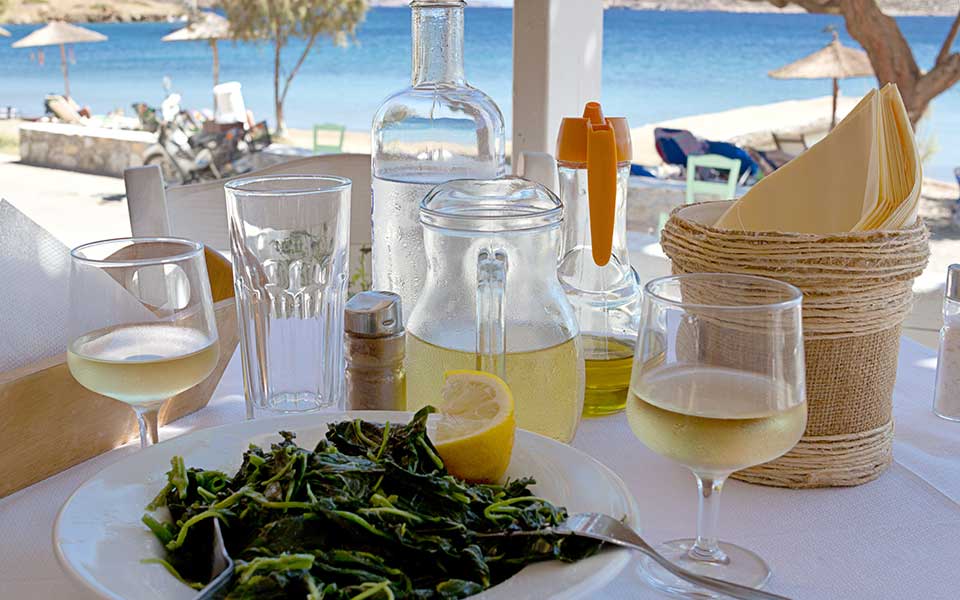Restaurant Road Trips: Four Places Worth the Drive...
This article explores four cozy Greek...

When visiting some traditional tavernas you can opt to go inside and check out the dishes of the day through a glass partition.
© Shutterstock
One of the most representative dishes of “Greek summer,” this green beans dish is made with plenty of olive oil (ladero means “oil-based”), tomato and onions. Vegetarians can accompany it with feta cheese (vegans cooking it at home can use feta substitutes – there are several in the Greek market) or simply a nice hunk of bread to dip into the delicious sauce.
These “giant” beans are commonly baked to a creamy, tender consistency in the oven with plenty of olive oil and fresh tomato as well as onion and fresh herbs such as parsley and dill. This very appetizing dish can easily be a meal in itself.
Lentils make for the classic winter soup made with green or brown lentils (of any size) and onion and as a refreshing and satisfying salad in summer. Modern Greek restaurants often serve jazzy renditions of lentil salad, in which they add a variety of different ingredients to produce creative results.
For this chickpea stew, chickpeas are cooked overnight in a clay pot until they are melt-in-your-mouth succulent in this stew recipe that’s traditionally made in Sifnos but also served around Greece. Other times it’s more a nutrient-dense soup than stew, traditionally made with onion, rosemary and lemon in wintertime.
Chickpeas are also made into revithokeftedes, or chickpea patties, the Greek version of falafel.
A thick soup traditionally made with cannelini-type white beans (small or medium sized) and carrots, parsley, tomato, onion and dill. A perfect dish for a cold winter’s day, especially when enjoyed with a warm hunk of bread that you can dunk into it.
Sometimes described as “the Greek ratatouille,” this ladero medley of seasonal veggies like aubergine, courgette, onion, potato, tomato and herbs is a delicious meal especially on a summer’s day and for vegetarians, ideally eaten with a side of (regular or vegan) feta cheese.

Stuffed tomatoes, called "domates gemistes" can be made with a filling of rice or a mix of rice and minced meat, so be sure to ask.
© Shutterstock
Gemista, which means “stuffed” are usually tomatoes, green bell peppers, courgettes, and more rarely aubergines, that are stuffed with rice. Their pulp is scooped out and added to the rice stuffing, which usually includes parsley, dill, basil, mint, pine nuts and raisins. Sometimes, minced meat is also added, so make sure you ask before you order.
Traditionally made with large, fresh juicy peas (which are in season from spring to mid summer) this is another oil-rich ladero dish that also contains carrot, tomato, onion and potato and is thus both highly nutritious and very tasty because of the many textures, colors and tastes it contains.
A feel-good risotto-style dish that’s traditionally made with creamy rice and fresh spinach as well as plenty of spring onions and dill. This classic is very filling and can comprise of a meal in itself one of your dishes in the middle.
Aubergine lovers rejoice – since the Papoutsaki (aubergine slices covered in a minced beef sauce and cheesy bechamel cream) is not appropriate, here is the next best dish – aubergine topped with sweet, juicy tomato sauce cooked with plenty of seasonings and herbs.
To make dolmadakia, vine leaves (fresh or preserved in brine and bought in a tin or jar) are stuffed with rice and other seasonings such as dill and spring onion, rolled into a cigar shape and simmered until tender. They are as they are, with lemon juice, Greek yoghurt, or avgolemono (egg-lemon sauce). There are also dolmadakia that contain meat, so ask about it before you order.

Boiled greens like horta or vlyta are delicious doused in olive oil and freshly squeezed lemon juice, with a good sprinkling of salt.
© Shutterstock
Even without the slice of feta cheese that it is traditionally topped with, the Greek salad is always a filling, tasty and refreshing option. If you’re having it at home, try out one of the replacement vegan cheeses on the market for the feta effect.
Vlita or horta are wild greens that are boiled and served with olive oil and fresh lemon juice. Horta are also used in cheese-free hortopita pies that includes a variety of wild herbs that add even more flavor, but these are only commonly available at tavernas and bakeries during lent.
Tip: If you’re making them at home make sure you give them a very good wash to get all the earth out, and once boiled, strain and drink their liquid as a mineral-rich, detoxifying tea with a squeeze of lemon.
Made with mashed potato, olive oil and a lot of garlic (skordo), or with a lot of garlic and other ingredients like ground almonds or ground walnuts, this pungent dip is traditionally eaten with bread, boiled beets, and for pescatarians, fried battered cod.
Made with yellow split peas that are especially famous in Santorini but also produced in several other regions of Greece, this creamy and healthy side dish is traditionally eaten with a slug of olive oil, chopped raw onion or caramelized onion and capers.
This aubergine dip is usually made by smoking the aubergines over a fire until the skin is black and then scooping out the pulp and mixing it with garlic, parsley, olive oil and a little tomato. There are several renditions but what remains the same for all is that melitzanosalata is one of the tastiest things to pile onto your bread.
A Santorini specialty made on the Cycladic island using highly flavorful tomatoes that grow with water from the air’s humidity, tomato fritters are one of the most “fun” of Greece’s traditional vegan menu, as they are gooey and delicious on the inside and crunchy (from being deep or shallow fried) on the outside.
A perfect side that is both yummy and filling, this potato dish can be enjoyed warm or at room temperature and is eaten throughout the year. It’s not one of the common dishes you’ll find at most restaurants but it’s always worth asking for.
Like the domatokeftedes, this dish of thinly sliced, battered and deep fried courgettes is one of the “naughty” vegan options you’ll find at many tavernas across Greece. Vegetarians traditionally eat it with a side of tzatziki (yoghurt with cucumber and garlic) but it can also be nice with skordalia or on its own with a drizzle of lemon and a sprinkling of black pepper.
This article explores four cozy Greek...
Mimosa shrubs and sweet acacia and...
One of the most impressive canyons...
Among the many city eateries offering...